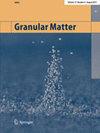A discrete particle model considering particle shape and its simulation study of isolated draw
Abstract
The flow characteristics of granular materials under gravity represent the primary scientific challenge involved in caving mining. Conducting in-depth research in this area contributes to improving ore recovery results. This study introduces an innovative discrete particle dynamics model that combines the advantages of soft-sphere and hard-sphere algorithms to significantly improve the simulation of granular flow in caving mining. The proposed soft-hard sphere coupling model achieves remarkable computational efficiency while accurately capturing the influence of particle shape on flow behavior. By developing a specialized collision resolution algorithm and implementing advanced contact detection methods, the model successfully simulates the isolated draw process for particles of various shapes, including circular, polygonal and elliptical particles. The reliability of the model is thoroughly validated through comparison with physical experiments and theoretical models. Furthermore, the study demonstrates how the rolling resistance coefficient can effectively characterize particle shape effects in circular particle simulations, providing a practical approach to balance computational efficiency and accuracy. These developments offer valuable insights for optimizing ore recovery in caving mining operations.
Graphical abstract

 求助内容:
求助内容: 应助结果提醒方式:
应助结果提醒方式:


